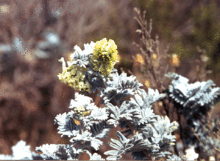Astragalus pycnostachyus var. lanosissimus
| Astragalus pycnostachyus var. lanosissimus | |
|---|---|
| Scientific classification | |
| Kingdom: | Plantae |
| (unranked): | Angiosperms |
| (unranked): | Eudicots |
| (unranked): | Rosids |
| Order: | Fabales |
| Family: | Fabaceae |
| Subfamily: | Faboideae |
| Tribe: | Galegeae |
| Genus: | Astragalus |
| Species: | A. pycnostachyus |
| Variety: | A. p. var. lanosissimus |
| Trinomial name | |
| Astragalus pycnostachyus var. lanosissimus (Rydb.) Munz & McBurney ex Munz | |
| Synonyms | |
Astragalus pycnostachyus var. lanosissimus, the Ventura marsh milk-vetch is a short-lived, herbaceous perennial in the pea family Fabaceae,[1]
Description
Astragalus pycnostachyus var. lanosissimus has dense clusters of small light yellow flowers. It has silvery white, pinnately compound leaves and flowers from June through October. The species was listed as endangered in 2001 by the U.S. Fish and Wildlife Service.[2]

Distribution
Historically, Astragalus pycnostachyus var. lanosissimus or Ventura marsh milk-vetch occurred in back dune habitat and coastal meadows, and near coastal salt marshes from Ventura County to Orange County. Over the last century seven historical occurrences were known to exist.
The species was extirpated from these sites and was therefore thought to be extinct until it was rediscovered in June 1997 by a USFWS biologist at a proposed development site.[3] It had only been seen twice in the last century.[1] Today, only this one population is known to exist near the City of Oxnard in Ventura County, all within a 2,854 square feet (265.1 m2) area (less than 0.6 of an acre).[4] The population occurs on disturbed coastal backdunes at the edge of the Oxnard Plain on fill material at a closed oil-waste dump site.[5]
Conservation
Since 1997 between 192 and 374 individual plants have been observed on the site.[6] Most of these individuals are seedlings or small juveniles. Southern California coastal wetland habitats have declined by 80–90% and those remaining are frequently degraded. Very little is known about the ecological requirements of this species.
This only known population of Ventura marsh milk-vetch is threatened by predation and potential habitat modification and may be susceptible to alterations in its hydrologic regime and competition from non-native plant species.[4]
The DFG is working closely with the landowner, the USFWS and other interested parties to identify areas that may be suitable for introducing Ventura marsh milk-vetch as part of recovery for the species. Greenhouse studies on this species are ongoing, as well as research to learn more about the ecological requirements of this species.[7]
References
- 1 2 Calflora
- ↑ "U.S. FISH AND WILDLIFE SERVICE LISTS VENTURA COUNTY PLANT AS ENDANGERED " News Release May 17, 2001 U.S. Fish and Wildlife Service
- ↑ "U.S. Fish and Wildlife Service Designates Critical Habitat for Plant in Santa Barbara and Ventura Counties" News Release May 20, 2004 U.S. Fish and Wildlife Service
- 1 2 CPC Plant Profile - National Collection of Endangered Plants Archived August 23, 2009, at the Wayback Machine.
- ↑ "Astragalus pycnostachyus var. lanosissimus". Plant Profile. Center for Plant Conservation. Retrieved 20 October 2016.
- ↑ Chi, Chris (August 15, 1997) "Rare Plant Discovered on Development Site" Los Angeles Times
- ↑ California Dept. of Fish & Game "Assessment Of Experimental Outplantings Of The Endangered Ventura Marsh Milkvetch"